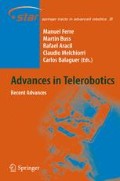Summary
The presence of a significant time delay in the communications between the local and remote zone of a teleoperated system causes two undesirables effects: (1) dynamic instability and (2) unmanageability. Instability usually appears in bilateral control schemes as a consequence of force feedback and makes the system useless with 0.1 or more seconds of time delay. Robot teleprogramming was proposed as an intermediate solution between supervised control systems and direct teleoperation when a significant delay appears in the communications between the local and the remote zones. In this chapter a teleprogramming architecture with an analyzer for the operators intention is proposed and tested. A task analyzer observes the movements made by the operator in a virtual environment. Through the force and geometric information obtained (attending only to geometric features), a set of symbolic commands are generated. These commands are then transmitted to an interpreter which pipes them through the communication system to the remote zone. The remote system receives and translates the information to absolute references in the remote model that is continuously actualized by the perception system.
Access this chapter
Tax calculation will be finalised at checkout
Purchases are for personal use only
Preview
Unable to display preview. Download preview PDF.
References
G. Hirzinger, B. Brunner, J. Dietrich and J. Heindl. Sensor-Based Space Robotics-ROTEX and Its Telerobotic Features. IEEE Trans. on Robotics and Automation, 9:649–663, 1993.
W.K. Yoon, T. Goshozono, H. Kawabe, M. Kinami, Y. Tsumaki, M. Uchiyama, M. Oda, and T. Doi. Model-Based Space Robot Teleoperation of ETS-VII Manipulator. Transactions on Robotics and Automation, Vol. 20:602–612, 2004.
I. Belousov I, S. Chebukov, and V. Sazonov. Web-based Teleoperation of the Robot Interacting with Fast Moving Objects. In Proc. of the 2005 IEEE International Conference on Robotics and Automation, 2005.
W.R. Ferrel and T.B. Sheridan. Supervisory control of remote manipulation. IEEE Spectrum, 1967.
G. Niemeyer and J. Slotine. Telemanipulation with time delays. International Journal of Robotics Research Vol. 23:873–890, 2004.
T.B. Sheridan. Telerobotics and Human Supervisory Control. The MIT Press, 1992.
T.B. Sheridan. Space Teleoperation Through Time Delay: Review and Prognosis. IEEE Transactions on Robotics and Automation Vol. 9:592–606, 1993.
A.K. Bejczy, S. Venema, and W.S. Kim. Role of Computer Graphics in Space Telerobotics: Preview and Predictive Displays. In Proc. SPIE Cooperative intelligent Robotics in Space Vol. 1387:365–377, 1990.
A. Kheddar. Teleoperation Based on the Hidden Robot Concept. IEEE Transactions on Systems, Man, and Cybernetics Vol. 31:1–13, 2001.
T. Kotoku, K. Tanie, and A. Fujikawa. Force reflecting bilateral master-salve teleoperation system in virtual environment. In Proc. Int. Symposium on Artificial Intelligence, Robotics and Automation in Space: pages 295–298, 1990.
K. Machida, Y. Toda, and T. Iwata. Graphic-simulator-augmented teleoperation system for space applications. Journal of Spacecraft and Rockets Vol. 21:64–69, 1990.
Y.J. Cho, T. Kotoku, and T. Tanie. Discrete-Event-Based Planning and Control of Telerobotic Part-Mating Process with Communication Delay and Geometric Uncertinty. In Proc. IEEE/RSJ/GI Int. Conference on Intelligent Robotics, 1995.
A.K. Bejczy, P. Fiorini, W.S. Kim, and P. Schenker. Toward Integrated Operator Interface for Advanced Teleoperation under Time Delay. In Proc. IEEE/RSJ/GI Int. Conference on Intelligent Robotics, 1994.
C. Sayers. Remote Control Robotics. Springer-Verla, New York, 1998.
C.H. Spenny and D.L. Schneider. Object Resolved Teleoperation. In Proc. IEEE International Conference on Robotics and Automation, 1997.
T. Backmon, and L.W. Stark. Model-based Supervisory Control in Telerobotics. Presence Vol 5(2):205–233, 1996.
J.E. Lloyd, J.S. Beis, K.D. Pai, and D.G. Lowe. Model-based Telerobotics with vision. In Proc. IEEE International Conference on Robotics and Automation, 1997.
T. Burkert, J. Leupold, and G. Passig. A Photorealistic Predictive Display. Presence Vol. 13:22–43, 2004
M. Skubic and R.A. Volz. Learning Force-Based Assembly Skills from Human Demostration for Execution in Unstructured Environments. In Proc. IEEE International Conference on Robotics and Automation, 1998.
A. Kheddar, T. Tanie, and P. Coiffet. Detection of discrepancies and sensorybased recovery for virtual reality based telemanipulation systems. In Proc. IEEE International Conference on Robotics and Automation, 1998.
D. Baraff. Interactive simulation of solid rigid bodies. IEEE Computer Graphics and Applications 15:63–75, 1995.
S. Hasegawa and M. Sato. Real-time Rigid Body Simulation for Haptic Interactions Based on Contact Volume of Polygonal Objects. EUROGRAPHICS 23:529–538, 2004.
A. Gregory, M.C. Lin, S. Gottshalk, and R. Taylor. A framework for fast and accurate collision detection for haptic interaction. In Proc. IEEE Virtual Reality Conference, pages 38–45, 1999.
E. Gat. Integrating planning and reacting in a heterogeneous architecture for Mobile robots. SIGART Bulletin Vol. 2:17–74, 1991.
W.K. Yoon, S. Tachihara, Y. Tsumaki, and M. Uchiyama. Evaluation of the Different Master Device Approaches for a Model-Based Space Teleoperation System. In Proc. International Conference on Advanced Robotics, 2001.
Author information
Authors and Affiliations
Editor information
Editors and Affiliations
Rights and permissions
Copyright information
© 2007 Springer-Verlag Berlin Heidelberg
About this chapter
Cite this chapter
Hernando, M., Gambao, E. (2007). Teleprograming: Capturing the Intention of the Human Operator. In: Ferre, M., Buss, M., Aracil, R., Melchiorri, C., Balaguer, C. (eds) Advances in Telerobotics. Springer Tracts in Advanced Robotics, vol 31. Springer, Berlin, Heidelberg. https://doi.org/10.1007/978-3-540-71364-7_19
Download citation
DOI: https://doi.org/10.1007/978-3-540-71364-7_19
Publisher Name: Springer, Berlin, Heidelberg
Print ISBN: 978-3-540-71363-0
Online ISBN: 978-3-540-71364-7
eBook Packages: EngineeringEngineering (R0)

